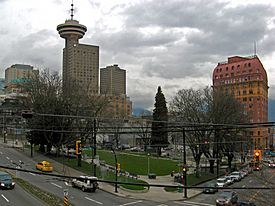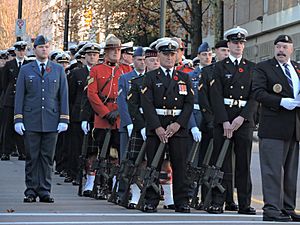Victory Square, Vancouver facts for kids
Quick facts for kids Victory Square |
|
|---|---|

Victory Square park, Vancouver
|
|
| Type | Public Park |
| Location | Vancouver, British Columbia |
| Area | 0.9 acres (0.36 ha) |
| Created | 1886 |
| Operated by | City of Vancouver |
Victory Square is a well-known park located in Vancouver, British Columbia, Canada. It's surrounded by West Hastings Street, West Pender Street, Cambie Street, and Hamilton Street. Sometimes, people also use "Victory Square" to talk about the area right around the park.
Contents
History of Victory Square
Victory Square was once the site of Vancouver's first courthouse. This old courthouse was taken down between 1911 and 1913. A new, bigger courthouse, designed by Francis Rattenbury, opened on Georgia Street. Today, that building is the Vancouver Art Gallery.
How the Park Area Was Chosen
The location of Victory Square was very important when it was picked. It sits where the old Granville townsite (also called Gastown) met the land given to the Canadian Pacific Railway (CPR). This land was part of the deal to build the railway's main station in Vancouver. The corner of Hastings and Hamilton Street is where the city's street system officially began. On February 13, 1886, a small part of this land, about 0.9 acres (3,600 m2), was set aside as "Government Square."
The Great Fire of 1886
Before 1886, most of downtown Vancouver, including the area of Victory Square, was a thick rainforest. There were tall trees and even a small creek. The CPR hired workers to clear the forest. They cut down trees, leaving piles of wood. This wood became fuel for the huge fire that destroyed much of Vancouver on June 13, 1886.
The clearing crews from the CPR barely escaped the fire. They ran down the hillside of what is now Victory Square to their hotel, the Regina Hotel. They had prepared by storing water and wetting blankets. Because of their preparations, the Regina Hotel was one of the only buildings in that part of the city to survive the fire.
Buildings Around the Square
When the old courthouse was still there, the area around Victory Square was a busy place for banks and lawyers. Many important buildings were built around the square, even when people knew the courthouse would be torn down. The Dominion Building, the Province Building, and the Sun Tower were all built quickly around this time. These buildings still stand today.

The maple trees on the Pender Street side of the park are the oldest street trees in Vancouver. They were planted in 1897.
Victory Square Cenotaph
On the north side of Victory Square, facing Hastings Street, is the Vancouver war memorial called the Cenotaph. A cenotaph is a monument built to honor people whose bodies are buried somewhere else. This one is about 30 feet (9.1 m) tall and has a triangular shape, matching the park. It's made of granite stone with special words carved into it. People often place flowers and flags around it.

Unveiling the Cenotaph
The Cenotaph was officially revealed on April 27, 1924. The Mayor of Vancouver, William Reid Owen, was there, along with 25,000 people. Many military groups attended, including soldiers who fought in World War I. Major Cecil C. Owen, a chaplain, dedicated the monument.
The dedication included these words:
To the Glory of God, and in thankful remembrance
of those who served their King and Country overseas in the cause of truth, righteousness and freedom.
Music was played, and prayers were said. The mayor's wife, W.R. Owen, placed the first wreath from the people of Vancouver.
Design and Meaning
The Cenotaph has carvings of a sword, wreaths of laurels (for victory), and poppies (for remembrance). It also has maple leaves, a symbol of Canada. At the bottom, the numbers "1914–1918" are carved, marking the years of World War I. Flags like the Union Jack and the Flag of Canada are always flying there, placed by groups like the Royal Canadian Legion.
The monument was designed by Major G.L. Thornton Sharp. Its triangular shape fits the park perfectly. It's placed so that when you look down Hastings Street from the east, the Cenotaph appears right in the middle. The stone for the monument came from Vancouver Granite Co., Ltd.
Inscriptions on the Cenotaph
The Cenotaph has three important inscriptions:
- Facing Hastings Street: "Their name liveth for evermore" and "1914–1918".
- Facing Hamilton Street: "Is it nothing to you".
- Facing Pender Street: "All ye that pass by".
The first quote is from the Bible, from a book called Sirach. The other two quotes are from the Bible, from the Book of Lamentations.
Major Owen, at the dedication, said: "Those whose sacrifices this Cenotaph commemorates, were among the men who, at call of King and Country, left all that was dear, endured hardship, faced danger, and finally passed out of the sight of men by the path of duty, giving their own lives that others might live in freedom. Let those who come after see to it that their names be not forgotten."
The Cenotaph is still the main place in Vancouver for the annual Remembrance Day services, where people honor those who served in wars.
Why This Location is Special
The Cenotaph is in a very meaningful spot. During World War I, men signed up to join the army at tables set up at the foot of the old courthouse steps. This was a powerful symbol because the courthouse was where many important official events happened, including visits from members of the royal family.


